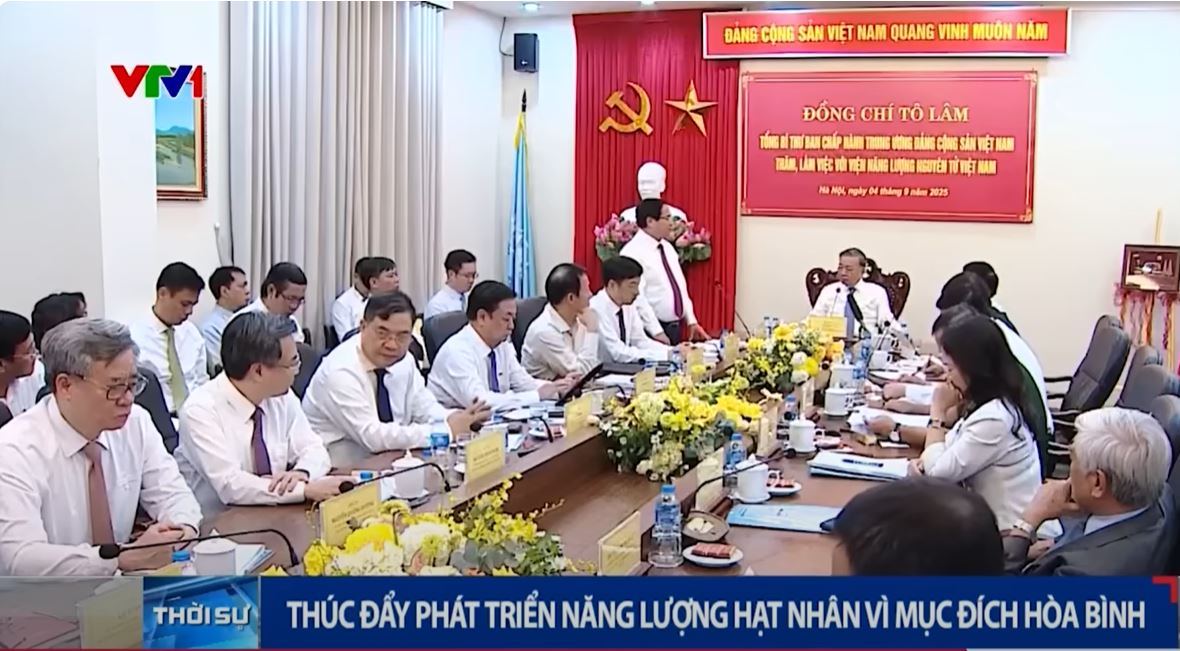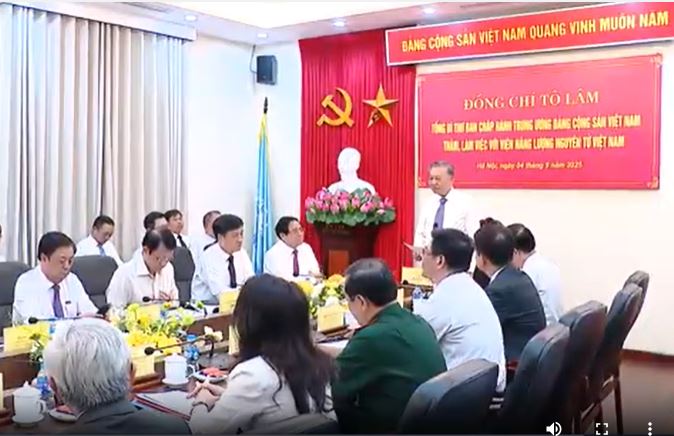- Nghiên cứu - Phát triển
- Hoạt động khoa học
NGHIÊN CỨU TỐI ƯU HÓA MÔ HÌNH NẠP NHIÊN LIỆU CHO LÒ HẠT NHÂN VVER-1000
Motivation
In-core fuel management (ICFM), i.e. fuel loading pattern (LP) optimization, is an important task in designing a nuclear reactor core, and is performed after each fuel cycle for most nuclear reactors. Fuel loading pattern is an arrangement of the fuel assemblies in the reactor core. The main task of ICFM is to determine the optimal fuel loading pattern. An optimal arrangement can give the best fuel efficiency, for the maximum total energy generated in a cycle while ensuring safety requirement. In a reactor core, there are many types of fuel assemblies with different enrichments and burnup levels. Therefore, the loading pattern optimization problem is a complex problem with a large number of possible loading patterns. This dissertation focuses on the development of advanced method for fuel loading pattern optimization of VVER-1000 reactor which is Russian PWR technology, and was considered for Vietnam nuclear power program before 2016.
The issue of the ICFM problem is that the search space is too large (Table 1), so the developed optimization search processes can not confirm that the final found solution is global optimal one. Therefore, the current optimization studies focus on improving the convergence speed of the search process in order to find better and better solutions with the same number of trials. This study will address the issue by considering, improving and applying advanced optimization methods to enhance the convergence speed for solving the LP optimization problem. The two objectives of this dissertation are as follows:
1. Investigation of advanced optimization methods to the problem of loading pattern optimization of nuclear reactors.
2. Development of a calculation tool for optimizing the loading pattern for the VVER reactor.
Table 1. Estimation of the number of possible LPs and calculation time for the VVER-1000 MOX core

Research results
Developing and validating the LPO-V program: In this dissertation, a core physics calculation code (LPO-V) has been developed for VVER reactors, and coupled with optimization search methods. This code solves diffusion equations in triangular meshes based on finite difference method . Verification for the LPO-V code was performed based on the VVER-1000 MOX benchmark core in comparison with MCNP4c calculations.
Figure 1 shows the 1/6th core model is simulated using the LPO-V code. Four-group cross section set of the fuel assemblies was prepared from lattice calculations using the PIJ code of the SRAC2006 code system and the ENDF/B-VII.0 data library.
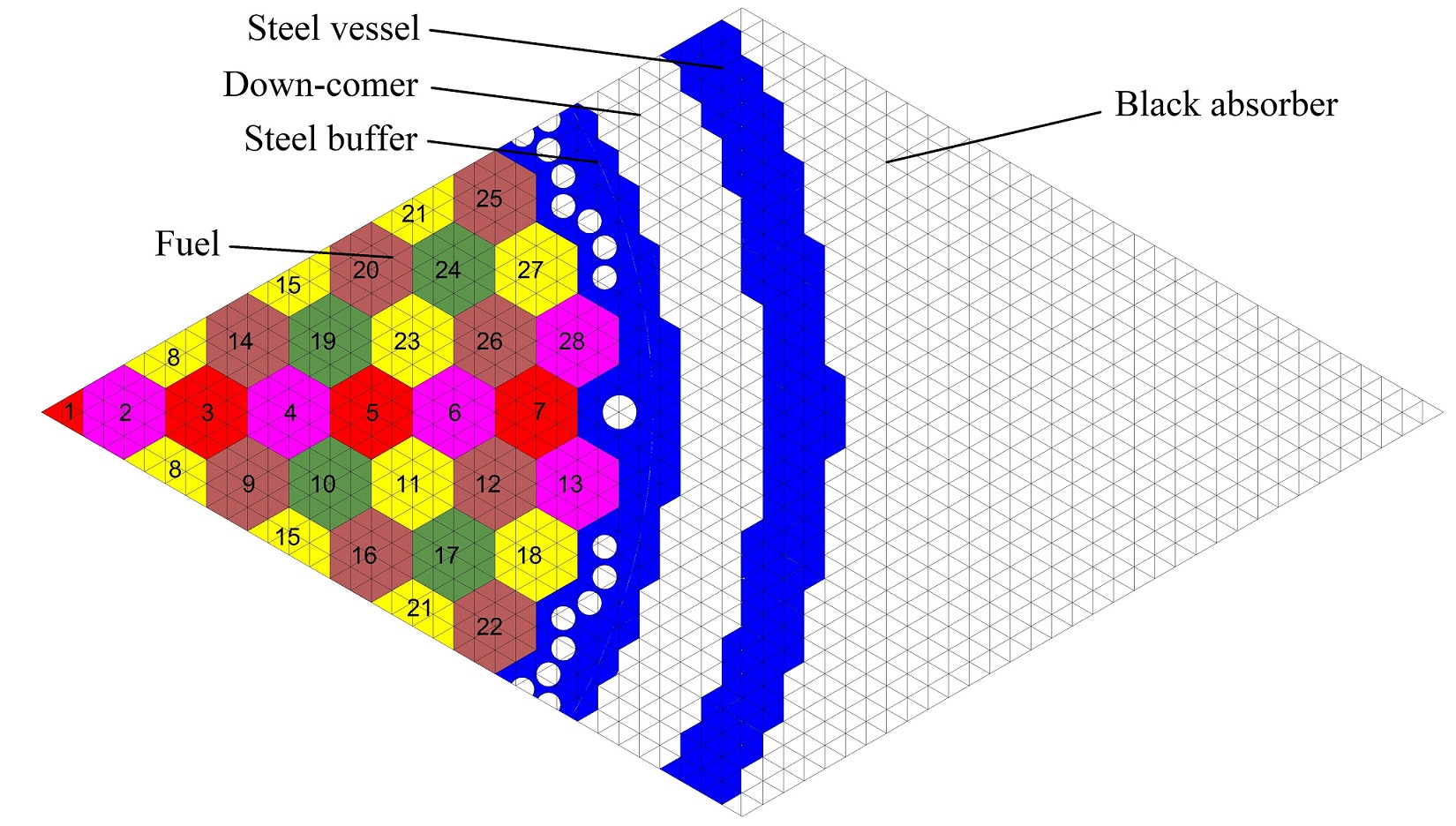
Figure 1. VVER-1000 core model with 24 triangular meshes per assembly in the LPO-V code
Verification of the core calculations using the LPO-V code has been conducted based on the reference configuration of the VVER-1000 MOX fuel benchmark core. Table 2 shows the comparison of the k_eff values obtained from the LPO-V code in comparison with that obtained from the MCNP4c calculations presented in the benchmark report. The comparison results imply that the two codes have a good agreement.
Table 2. Comparison of the k_eff values calculated with the LPO-V and MCNP4c codes for five states (S1--S5) of the VVER-1000 MOX benchmark core

A calculation speed test was also performed by comparing between LPO-V and CITATION module of the SRAC2006 code. The computational time of 2000 core LPs using the LPO-V code is about 340 s, which is faster than the CITATION module of the SRAC code system (1040 s) running on the same system with the same core models by a factor of 3.0. Thus, the LPO-V code is suitable for the problem of fuel loading optimization with a large number of calculated LPs.
Studying and developing optimization methods: Two advanced optimization methods have been developed for the problem of fuel loading optimization of VVER-1000 reactor: Evolutionary Simulated Annealing (ESA) method and discrete Success-History based Adaptive Differential Evolution (SHADE) method. The ESA method which was improved from the original simulated annealing (SA) by using crossover and mutation operators to generate new trial loading patterns. The SHADE method uses an adaptive mechanism based on a historical record of successful control parameters, i.e. mutant scale F and crossover ratio CR, to improve the original Differential Evolution (DE) algorithm. Therefore, instead of three control parameters in the original DE, the SHADE method consists of two parameters of population size NP and memory size $H$. To apply SHADE method to the fuel LP optimization, a relative position indexing approach was deployed to convert real variables into integer variables. Calculation surveys was performed to select suitable control parameters of the SHADE for the LP optimization problem of the VVER-1000 MOX core.
Numerical calculations for optimizing fuel LP of the VVER-1000 MOX core have been conducted using the ESA and SHADE methods in comparison with Simulated Annealing (SA) and Adaptive Simulated Annealing (ASA). Two fitness functions were used to evaluate the performance of the methods as well as find the optimal LP for the VVER:
The F2 was chosen to maximize the effective multiplication factor (keff), while flattening the radial power distribution.
To compare the performance of SA, ASA and ESA, the search processes using the three methods were firstly performed with the fitness function F1 for reproducing a reference LP. The average results of the 50 independent runs are summarized in Table 3. This result indicates the better performance of ESA in reproducing a reference LP compared to SA and ASA.
Table 3. Comparison of the SA, ASA and ESA methods with the F1

Table 4 shows the results of the SA, ASA and ESA methods with the fitness function F2. One can see that the F2 values of ESA are greater than that of SA and ASA with smaller standard deviations, at the same time the number of calculated LPs in ESA are smaller than SA and ASA by about 5--10% in most cases. The results indicate that the new generation of trial LPs via the crossover and mutation could improve the performance of the ESA method in the LP optimization problem of VVER-1000 core.
Table 4. Comparison of the SA, ASA and ESA methods with the F2

In the SHADE, a survey has been conducted to determine the control parameters NP and H, in which, NP was varied from 10 to 50 with a step of 5, and H was varied from 2 to 10. Figure 2 shows the dependence of the average optimal fitness as a function of NP and H. From Figure 2, the values of NP = 20 and H = 6 have been selected for further optimization using the SHADE method.
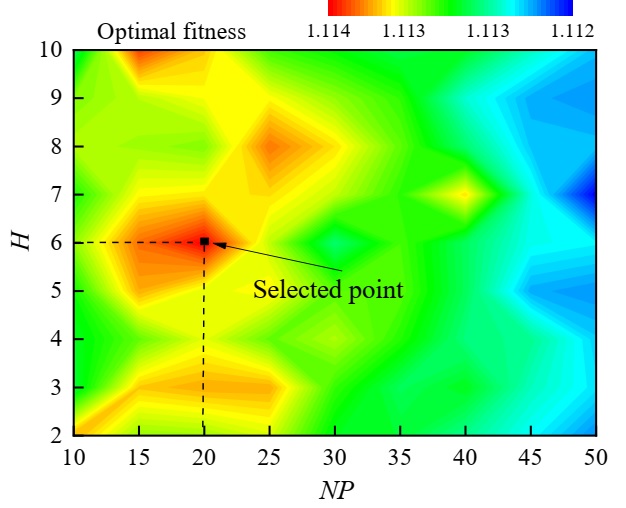
Figure 2. A survey of control parameters NP and H. The values of NP=20 and H=6 were selected for further optimization process
The two methods were applied to LP optimization of VVER-1000 reactor with theo fitness function of F2. In the ESA, the numerical calculations were performed with values of alpha as 0.95 and the additional criterion as 10000. Figure 3 (a) shows the evolution of the average fitness function values of the VVER-1000 MOX core during the ESA, SA and ASA search processes. The results show that the ESA can find the optimal LP with the best of fitness function value. In the SHADE, Figure 3 (B) depicts the evolution of the average fitness function with the number of generations. The results show that the advantage of the individuals selected in each generation compared to the trial solutions. Also, the fitness function of the best solutions is usually better that that of the individuals.
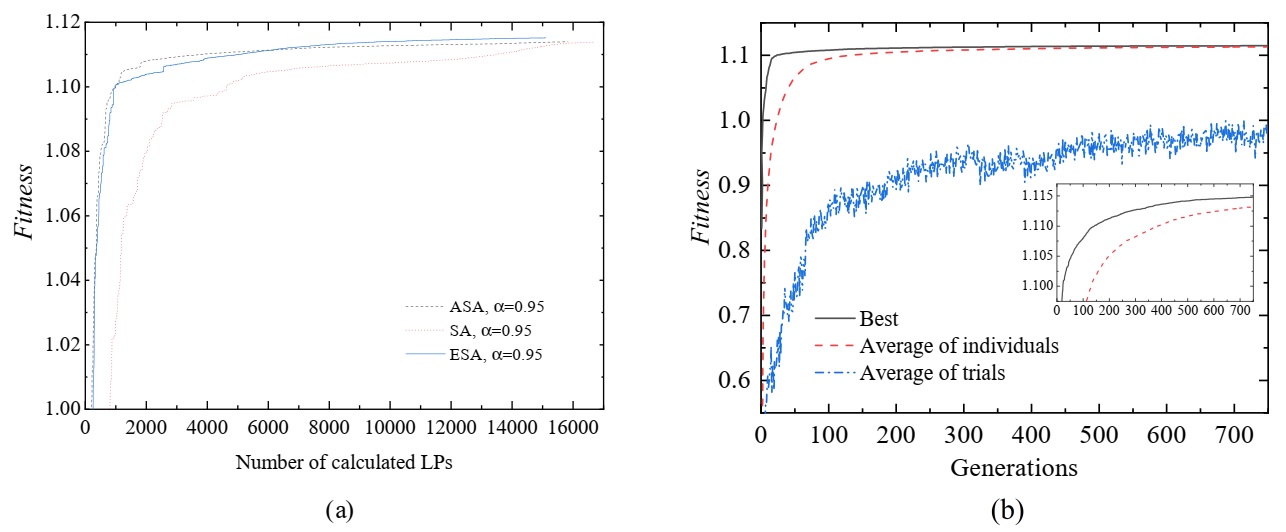
Figure 3. Evolution of the fitness function in the ESA (a) and SHADE (b)
The searches results show the optimal LPs found by the ESA and the SHADE are identical. The k_eff of optimal LP is greater than that of the reference core by about 1834 pcm. Whereas, the radial power peaking factor (PPF) of the optimal LP is about 2.4% smaller than that of the reference core (Table 5 and Figure 4). Statistical differences between these methods were also evaluated based on the Mann-Whitney U test. The results show that the ESA and SHADE methods are advantageous over SA and ASA.
Table 5. Comparison of the optimal LP obtained from the search process with the reference one
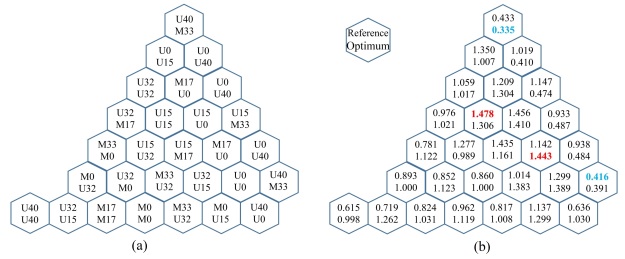
Figure 4. Optimal core LP (a) and its relative radial power distribution (b) in comparison with the reference one
Conclusion
In this dissertation, the studies aim at developing advanced metaheuristics methods, i.e. ESA and SHADE, and applying to the ICFM problem of the VVER-1000 reactor. The following studies have been carried out:
(1) Development of the LPO-V code, has been conducted to calculate the neutronic characteristics of VVER reactors with fast computational speed and acceptable accuracy. This code is coupled with the newly developed optimization methods for solving the ICFM problem of VVER-1000 reactor.
(2) Development of advanced optimization methods, ESA and SHADE, has been conducted and applied successfully to the LP optimization problem of VVER-1000 reactor. The ESA is an improved version of the original SA method, that was proposed by the PhD student. Instead of using binary/ternary exchange operator to generate a new trial LP as in the SA, the ESA used a crossover of two base LPs for generating a new trial LP. The SHADE method is an advanced version of the DE method with the use of success-history based adaptation to determine the control parameters $F$ and $CR$ automatically. The RPI approach was deployed to convert real vectors to integer vectors in the discrete SHADE method. This research is the first research to apply the SHADE method to the ICFM problem.
(3) Numerical calculations were performed for optimizing the LP of the reference VVER-1000 MOX core using the ESA and SHADE methods in comparison with other methods. The comparison between ESA, SA and ASA show that the ESA is advantageous over SA and ASA in the problem of fuel LP optimization. In comparison of ESA, DE and SHADE methods, the three methods have comparable performance. However, the advantage of SHADE is that the adaptive mechanism simplifies significantly the determination of the control parameters compared to DE.
The optimal core LPs selected from the SHADE and ESA methods were similar. This LP have a significant improvement of the $k_{eff}$ value, which is greater than that of the reference core by about 1580 pcm. Whereas, the $PPF$ is smaller than the reference value by about 2.4\%, and the flatness values are approximate. The results demonstrate that the ESA and the discrete SHADE methods have been successfully developed and applied to the fuel loading optimization of the VVER-1000 reactor.
Proposal for future works
(1) The LPO-V code is being upgraded to simulate 3D reactor with triangular and rectangular meshes and perform burn-up calculation.
(2) Further investigation of the ESA, SHADE methods and new advanced methods are being planned. The extension of this study to multi-cycle optimization is also taken into account.
(3) Extension of the application of these methods to the LP optimization and core design for other reactor types is also being planned.
Publications used for contents of the dissertation
[1] Viet-Phu Tran, Giang T.T. Phan, Van-Khanh Hoang, Haidang Phan, Nhat-Duc Hoang, Hoai-Nam Tran; Success-history based adaptive differential evolution method for optimizing fuel loading pattern of VVER-1000 reactor; Nuclear Engineering and Design 377 (2021) 111125
[2] Viet-Phu Tran, Giang T.T. Phan, Van-Khanh Hoang, Pham Nhu Viet Ha, Akio Yamamoto, Hoai-Nam Tran; Evolutionary simulated annealing for fuel loading optimization of VVER-1000 reactor; Annals of Nuclear Energy 151 (2021) 107938
[3] Viet-Phu Tran, Hoai-Nam Tran, Akio Yamamoto, Tomohiro Endo; Automated Generation of Burnup Chain for Reactor Analysis Applications; Kerntechnik, ISSN 0932-3902, 82 (2017 ) 2 196-205.
[4] Viet-Phu Tran, Hoai-Nam Tran, Van Khanh Hoang; Application of Evolutionary Simulated Annealing Method to Design a Small 200 MWt Reactor Core; Nuclear Science and Technology, ISSN 1810-5408, Vol. 10, No. 4 (2020), pp. 16-23
[5] Nguyen Huu Tiep, Nguyen Thi Dung, Tran Viet Phu, Tran Vinh Thanh and Pham Nhu Viet Ha; Burnup calculation of the OECD VVER-1000 LEU benchmark assembly using MCNP6 and SRAC2006; Nuclear Science and Technology, ISSN 1810-5408, Vol. 8, No. 4 (2018), pp. 10-19
[6] Tran Vinh Thanh, Tran Viet Phu, Nguyen Thi Dung; A study on the core loading pattern of the VVER-1200/V491; Nuclear Science and Technology, ISSN 1810-5408, Vol. 7, No. 1 (2017), pp. 21-27.
[7] Tran Viet Phu, Tran Hoai Nam; Discrete SHADE method for in-core fuel management of VVER-1000 reactor; 45th Vietnam Conference on Theoretical Physics (VCTP-45), 2020 (Poster)
[8] Viet-Phu Tran, Hoai-Nam Tran, Van Khanh Hoang; Application of Evolutionary Simulated Annealing Method to Design a Small 200 MWt Reactor Core; 6th Conference on Nuclear Science and Technology for young researcher, 08-09/10/2020.
INST




.png)



